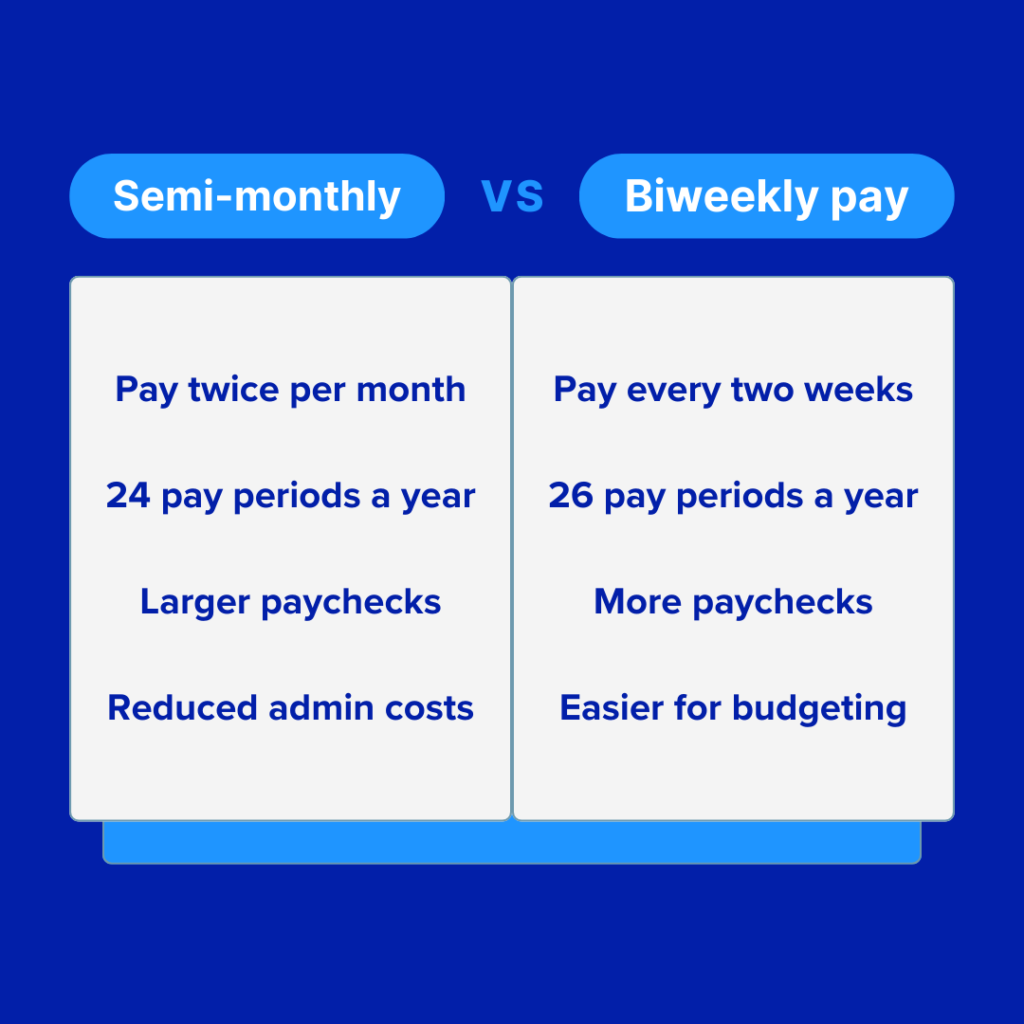One of the best things about work is getting paid — but it can be a struggle to establish a payroll period that works for everyone. If you’re reading this, you’re probably considering (or already decided on) semi-monthly pay.
For some, it’s easier to handle cash flow, balance employee morale, and find peace of mind with semi-monthly pay — especially if your customers are slow in making payments.
Are you looking for options to ensure your people are paid accurately and on time? Do you need help understanding what payroll periods are available and a fit for your operations? Or have your team members asked about new payment options to make it easier for them to have money in the bank when rent is due?
These questions are some of the core challenges of semi-monthly pay that we’ll discuss in this post.
Boost your team’s efficiency with Hubstaff's productivity tools
What is semi-monthly pay?
Let’s start simple with an understanding of what semi-monthly pay is. Semi-monthly pay is a payroll period where you pay employees twice a month.
Not to be confused with biweekly pay, companies on a semi-monthly payroll schedule typically use the 15th and 30th of each month — or the closest business day — as the cutoff for the time period. Sometimes, that means people get paid on those dates.
In other cases, those dates are the end of the pay period. If a business has hourly employees or contractors, employees are often paid up to five days after the pay period ends. This setup also gives the employer time to verify submitted hours and process payroll.
How many pay periods are in semi-monthly pay?
With semi-monthly pay, the math is pretty easy. With twelve months in a year and two pay periods for each, you’ll have 24 pay periods per year. That’s important when you work to calculate payroll hours.

What does semi-monthly pay mean compared to other models?
While many use semi-monthly and biweekly pay interchangeably, the semi-monthly vs. biweekly payment schedule is an important debate. These pay schedules are actually quite different due to the number of weeks in a month.
On average, people often round down to four weeks in a given month. However, there are actually 4.34 weeks in the average month. This means that some months have five weeks and, therefore, have the potential for three payments in one month. With semi-monthly pay, it does not matter what day of the month the week finishes on for this method.
How is semi-monthly pay calculated?
You can easily calculate a semi-monthly pay frequency because it’s very straightforward for hourly and salaried employees.
Let’s start with hourly employees. Determine that hourly wage and multiply it by the number of hours worked during the pay period.
If you’re paying your hourly workers $20 per hour and they worked 80 hours, you’d multiply to get a net pay of $1,600 for that half of the month. Don’t forget to deduct taxes, insurance costs, retirement benefits, and anything else when doing these calculations.
Salaried employees make this process a little easier. Take the entire annual salary and divide it by 24 — the total number of pay periods for semi-monthly pay. That gives you the total that you’ll pay a person each period.
If an employee has a total gross pay of $48,000 annually, you’ll divide that by 24. The answer, $2,000, is the amount they receive before any taxes, deductions, or withholdings. The process is very direct and means you don’t need to rely on some advanced semi-monthly pay calculator.
Tools like Hubstaff simplify this and automate much of the tracking, deductions, verification, and even payroll disbursement process for you.

Benefits of semi-monthly pay
Understanding semi-monthly pay is only half the battle. If you’re planning to switch to this model, the most important part is understanding why it benefits your people and your organization.
One of the most significant advantages of semi-monthly pay is its consistency. Because employees are paid on specific days of the month, they can better plan their finances and budget accordingly. Semi-monthly pay periods also make it easier for employers to calculate pay and ensure that employees are paid for the correct hours worked.
For hourly teams, semi-monthly pay also sets consistent expectations.
- Your team knows when they need to turn in their timesheets.
- Managers know when they need to approve things by
- HR or payroll staff know when everything must be submitted for proper disbursement
Everyone is on the same page, and there’s less risk of interruption or surprises.
There are also a few other benefits your team may experience:
- Pay is often larger compared to bi-weekly, which many employees prefer.
- Pay dates are consistent, helping people plan accordingly for bills like rent.
- Deductions for benefits are more consistent, making planning and payment easier for staff to manage.
- Employers process payroll fewer times than bi-weekly options, saving time and money.
- The set schedule makes it easier for businesses to understand salaries and wages, potentially identifying when they can raise salaries.
Disadvantages to semi-monthly pay
While semi-monthly pay can be beneficial for both team members and employers, there are also some disadvantages to consider.
The top concern is that teams are only paid twice a month, meaning they’ll wait longer for their paycheck than some options like biweekly pay. This delay can be especially difficult for people living paycheck to paycheck.
For companies, you’re looking at a few different challenges:
- You need a slightly larger cash reserve to pay your people. As your teams grow, so does this extra requirement.
- Payroll staff need to have clear processes. Explain them to people when things change, such as a holiday pushing back a pay period. Even so, bi-monthly payroll will likely cause more questions to HR over the course of the year because of the number of potential disruptions here.
- Hourly staff and shift workers may have inconsistent hours or pay. This is especially true when they earn overtime (and it will also increase admin work).
Sample semi-monthly pay schedule 2024
Here’s an example of what a semi-monthly pay schedule 2024 calendar might look like for your operations. Feel free to copy and paste this into your own separate spreadsheet. Just make sure you also update your disbursement date based on your company’s payroll practices.
Semi-monthly payroll calendar 2024
| Pay Period | Pay Period Start Date | Pay Period End Date | Optional Disbursement Date |
| 1 | 1-Jan | 15-Jan | 20-Jan |
| 2 | 16-Jan | 31-Jan | 5-Feb |
| 3 | 1-Feb | 15-Feb | 20-Feb |
| 4 | 16-Feb | 29-Feb | 5-Mar |
| 5 | 1-Mar | 15-Mar | 20-Mar |
| 6 | 16-Mar | 31-Mar | 5-Apr |
| 7 | 1-Apr | 15-Apr | 20-Apr |
| 8 | 16-Apr | 30-Apr | 5-May |
| 9 | 1-May | 15-May | 20-May |
| 10 | 16-May | 31-May | 5-Jun |
| 11 | 1-Jun | 15-Jun | 20-Jun |
| 12 | 16-Jun | 30-Jun | 5-Jul |
| 13 | 1-Jul | 15-Jul | 20-Jul |
| 14 | 16-Jul | 31-Jul | 5-Aug |
| 15 | 1-Aug | 15-Aug | 20-Aug |
| 16 | 16-Aug | 31-Aug | 5-Sep |
| 17 | 1-Sep | 15-Sep | 20-Sep |
| 18 | 16-Sep | 30-Sep | 5-Oct |
| 19 | 1-Oct | 15-Oct | 20-Oct |
| 20 | 16-Oct | 31-Oct | 5-Nov |
| 21 | 1-Nov | 15-Nov | 20-Nov |
| 22 | 16-Nov | 30-Nov | 5-Dec |
| 23 | 1-Dec | 15-Dec | 20-Dec |
| 24 | 16-Dec | 31-Dec | 5-Jan |
A brief guide to payroll periods:
Understanding payroll periods can be confusing, but it’s essential for remote business owners. Here is a quick guide to the most common types of payroll periods:
- Weekly pay. Employees are paid every week, typically on a Friday or Monday. Cutoff points are clear and consistent.
- Bi-weekly pay. Employees are paid every other week. This is especially common for full-time employees because it’s easy to set up once and run for a year.
- Semi-monthly pay. Employees are paid twice a month, offering consistency and reducing the number of pay periods a company must manage.
- Monthly pay. Employees are paid once a month. A strong option for full-time teams with higher pay rates where fewer members live paycheck to paycheck.
For more information and some additional comparisons between your options, check out this full guide to pay periods and how they work.

Ensure your choice improves your operations
Overall, semi-monthly pay is a common option that tends to benefit employers and their team members. It can be a little trickier in some situations, but you’ve got fewer pay periods and an easier method for businesses to predict expenses. There’s a good chance that it’s something you and your teams will appreciate.
When your operations rely on hourly teams, consider Hubstaff’s payroll tracking software designed to simplify the process. Not only can it help you track hours and see deeper data insights, but it can also help you:
- Simplify payroll
- Design and send custom invoices
- Create your own work orders
- Pull detailed reports
- See real-time productivity metrics
Give it a try today to simplify your payroll processes and decisions, giving everyone a better and more productive day.
A quick semi-monthly pay FAQ
What does semi-monthly pay mean?
Semi-monthly pay is a system where staff are paid multiple times a month based on specific dates. Typically, this is twice per month, and pay periods run from the first to the fifteenth and then the sixteenth to the end of the month.
Disbursements happen either at the end of the pay period — typically for salaried employees — or within five days after, giving HR time to process and approve submitted timesheets.
How many days are in a semi-monthly pay period?
On average, there are 15 days in a pay period. The number of business days or days worked will vary across each pay period as months start on different days of the week.
How many pay periods in semi-monthly pay?
Typically, there are two pay periods per month in semi-monthly pay configurations. With twelve months in a year, that comes out to 24 pay periods per year.
Wondering how to calculate semi-monthly pay?
Semi-monthly pay is a straightforward method. You’re doing direct, simple math, so there’s no need for any advanced semi-monthly pay calculator.
Here’s how you calculate semi-monthly pay for two types of team members:
- Hourly — Multiply the number of hours worked during the pay period by their hourly rate.
- Salaried — Divide the team member’s annual pay by 24 and pay them that amount each pay period.
Further read:
Most popular
The Fundamentals of Employee Goal Setting
Employee goal setting is crucial for reaching broader business goals, but a lot of us struggle to know where to start. American...
Data-Driven Productivity with Hubstaff Insights: Webinar Recap
In our recent webinar, the product team provided a deep overview of the Hubstaff Insights add-on, a powerful productivity measurem...
The Critical Role of Employee Monitoring and Workplace Security
Why do we need employee monitoring and workplace security? Companies had to adapt fast when the world shifted to remote work...
15 Ways to Use AI in the Workforce
Whether through AI-powered project management, strategic planning, or simply automating simple admin work, we’ve seen a dramatic...




